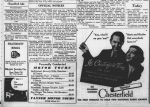Check your email. Look for any open job openings on BruinView. Confirm your attendance on a Facebook event page. Respond to a group text message by mentioning how excited you are. Set an alarm on your phone.
This is the typical life of a Bruin today. But Bruins in 1937 used the Daily Bruin to do all of this.
With today’s technology, Bruins are able to use various platforms to plan their college lives: Bruinwalk.com for figuring out which professors to learn from, MyUCLA to receive notifications from the administration and even a personal UCLA email to receive information about class field trips and other open opportunities.
But before the internet made its introduction on the UCLA campus, this future-digital campus lived on the pages of the school newspaper. The California Daily Bruin, which was our masthead before we dropped the “California” part, printed announcements from administrations. For example, the paper printed on April 16, 1937, included a broad announcement by then-campus women’s physician Lilian Titcomb, stating “all women students must make an appointment for an exam or lose their status as a student.”
Graduate students looking for teaching assistant positions could flip through the paper to find information on how to proceed with the job applications. An announcement on that same page reminded students applying for teaching assistant appointments in the history department to file their applications in Royce Hall before April 19, 1937.
The California Daily Bruin even used to publish short event notices. The same April 16 paper included the Kerckhoff Hall meeting schedules, listing meetings from student organizations such as the graduate student government, the Geographic Society and even the men’s glee club.
Nowadays, these same notifications can be easily added in and taken care of by our automated calendars – albeit, they’re significantly less copy-edited. Facebook reminders and incessant notifications on our phones have taken on one of the previous roles of the Daily Bruin.
And this underscores an interesting trend in today’s notion of time and punctuality. In 1937, these sorts of announcements would take a minimum of one day to push out, meaning deadlines were – to some extent – measured on a 24-hour basis.
Today, however, with notifications that can be programmed down to the minute, students are able to not just better pack their schedules, but better procrastinate completing their to-do lists, too. With constant reminders from various campus departments, be they UCLA Housing and Hospitality for roommate signups or the associate dean of the school of engineering reminding students to meet with faculty advisers, students face too many reminders – so much so, all our mobile devices even have the option to mute these notifications.
The question still remains as to which form of notices – today’s digital notifications or 1937’s paper-based memos – is more effective. But that’s something best left to students to answer.
